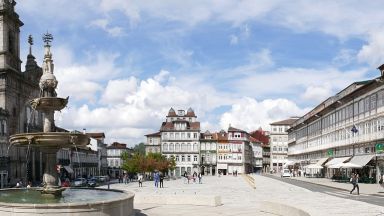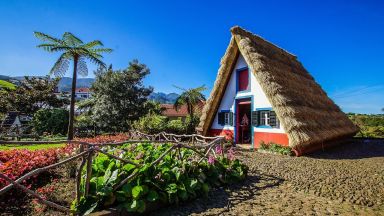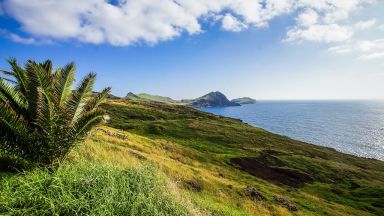Guimarães: The Complete Guide
Guimarães, often regarded by the Portuguese as the birthplace of their country, is blessed with an abundance of riches that can be almost overwhelming. Nestled at the base of a mountain range, this city, which served as the first capital of Portugal, has managed to preserve a medieval ambience at its core. It was in Guimarães where Afonso Henríques, the first king of Portugal and son of Henri de Bourgogne, a French nobleman, and his wife, Teresa, the daughter of the king of León and Castile, was born. Teresa, who received the county of Portucale as her dowry, eventually gave rise to the name “Portugal.” The area that comprised Portucale was the land that lay between the Douro and the Minho, which included present-day Porto. Teresa and Henri chose Guimarães as their court, where Afonso Henríques was born.
After the death of Henri, Teresa became the regent for the infant king. However, her affair with a count from Galicia and her strong ties with her native Spain caused her to fall out of favor with her subjects. Afonso, as a young man, led a rebellion against the regent’s forces outside Guimarães in 1128. His major victory came in 1139 when he defeated the Moors near Santarém. He broke away from León and Castile and declared himself king of Portucale. In 1143, Spain recognized the newly established kingdom.
In addition to Afonso Henríques, Guimarães was also the birthplace of Gil Vicente (1465–1537?), who is considered the father of Portuguese theatre and is often called the Shakespeare of Portugal. Although trained as a goldsmith, Vicente entertained the courts of both João II and Manuel I with his farces and tragicomedies, as well as his religious dramas.
Nowadays, Guimarães is a bustling town with a keen interest in trade, particularly in weaving, tanning, and the production of kitchenware and cutlery. It is also renowned for its handicraft industries, such as pottery, silver- and goldsmithing, and embroidery.
Visiting Guimarães for the first time and wondering what are the top places to see in the city? In this complete guide, I share the best things to do in Guimarães on the first visit. Top help you plan your trip, I have also included an interactive map and practical tips for visiting!
This website uses affiliate links which earn a small commission at no additional cost to you.
17 Best places to See in Guimarães
This complete guide to Guimarães not only tells you about the very best sights and tourist attractions for first-time visitors to the city but also provide insights into a few of our personal favorite things to do.
This is a practical guide to visiting the best places to see in Guimarães and is filled with tips and info that should answer all your questions!
Alberto Sampaio Museum

Location: Museu de Alberto Sampaio, Rua Alfredo Guimarães, Guimaraes, Portugal | Hours: 10am-6pm Tue-Sun | Price: adult/child €3/free, Sun morning free | Website | Distance: 0.00km
Visiting Alberto Sampaio Museum
Largo da Oliveira

Location: Largo da Oliveira, Guimaraes, Portugal | Distance: 0.10km
Visiting Largo da Oliveira
Praça de São Tiago

Location: Praça de São Tiago, Guimaraes, Portugal | Distance: 0.20km
Visiting Praça de São Tiago
Rua de Santa Maria

Location: Rua de Santa Maria, Guimarães, Portugal | Distance: 0.20km
Visiting Rua de Santa Maria
Igreja de São Francisco Guimarães

Location: Igreja de São Francisco, Rua Padre Gaspar Roriz, Guimarães, Portugal | Hours: 9.30am-noon & 3-5pm Tue-Sat, 9.30am-1pm Sun | Distance: 0.20km
Visiting Igreja de São Francisco Guimarães
Convento de Santa Clara (Guimarães)

Location: Antigo Convento de Santa Clara, Largo Cónego José Maria Gomes, Guimarães, Portugal | Distance: 0.20km
Visiting Convento de Santa Clara (Guimarães)
Largo do Toural

Location: Largo do Toural, Guimaraes, Portugal | Distance: 0.30km
Visiting Largo do Toural
Igreja de Nossa Senhora da Consolação (Guimarães)

Location: Igreja e Oratórios de Nossa Senhora da Consolação e Santos Passos, Largo de São Brás, Guimarães, Portugal | Hours: Monday to Saturday: 8 am-12 pm / 3 pm - 5 pm; Sunday 8 am-12 pm. | Distance: 0.30km
Visiting Igreja de Nossa Senhora da Consolação (Guimarães)
Largo dos Laranjais

Location: Largo dos Laranjais, Guimaraes, Portugal | Hours: 24 Hours | Distance: 0.30km
Visiting Largo dos Laranjais
Fonte do Largo Dr. João da Mota Prego (Guimarães)

Visiting Fonte do Largo Dr. João da Mota Prego (Guimarães)
Muralhas de Guimaraes

Visiting Muralhas de Guimaraes
Paço dos Duques de Bragança

Location: Paço dos Duques de Bragança, Rua Conde Dom Henrique, Guimaraes, Portugal | Hours: 10am-6pm | Price: adult/child €5/free | Website | Distance: 0.40km
Visiting Paço dos Duques de Bragança
Martins Sarmento Society

Location: Sociedade Martins Sarmento, Rua Paio Galvão, Guimaraes, Portugal | Hours: Tuesday-Friday: 9:30 a.m.–12:30 p.m./ 2:30 p.m.–5:30 p.m.; Saturday and Sunday: 10 a.m.-12:30 p.m./ 2:30-5:30 p.m. Closed: Monday and public holidays | Website | Distance: 0.40km
Visiting Martins Sarmento Society
Igreja de São Miguel do Castelo

Location: Igreja de São Miguel do Castelo, Rua Conde Dom Henrique, Guimaraes, Portugal | Hours: 10.00 a.m.-6.00p.m. (last entry 5.30 p.m.) Closed: 1 January, Easter sunday, 1 May and 25 December | Distance: 0.50km
Visiting Igreja de São Miguel do Castelo
Castelo de Guimarães

Location: Castelo de Guimarães, Rua Conde Dom Henrique, Guimaraes, Portugal | Hours: 10am‑6pm | Price: adult/child €2/free | Website | Distance: 0.60km
Visiting Castelo de Guimarães
Centro Cultural Vila Flor

Location: Centro Cultural Vila Flor (CCVF), Avenida Dom Afonso Henriques, Guimaraes, Portugal | Distance: 0.60km
Visiting Centro Cultural Vila Flor
Monte da Penha

Location: Penha, Guimarães, Portugal | Hours: Winter: Open Fridays, Saturdays, Sundays 10 am - 5:15 pm | Price: Adults €7.50, Children €3.50. | Distance: 2.30km
Visiting Monte da Penha


